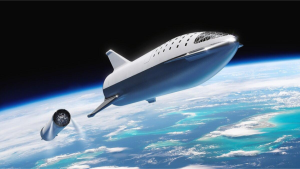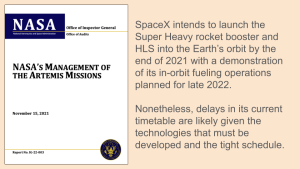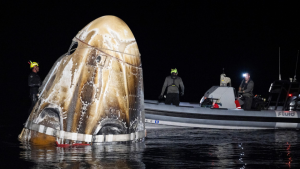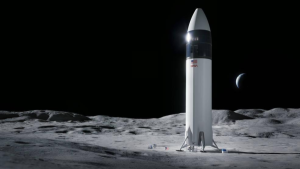I think it is fair to say that humans have dreamed of going to Mars for as long as we have known that Mars is a planet. We see these dreams in amazing books, like The Martian Chronicles and John Carter of Mars, and even in Percival Lowell’s attempts to map what we now see as fictional canals.
Humanity’s first successful Mars mission was the 1965 Mariner 4 Flyby, and today, two US rovers explore the Red Planet.
Mariner 4 was 60 years ago, and if the dreamers get what they want, we will have humans on Mars before the 70th anniversary of Mariner 4. … I’m just not sure that is going to happen, and I want to look at the facts behind this potential fiction.
Musk has been talking about his desire to have a fully reusable Mars vehicle since at least 2005, and in 2012 Musk told the BBC that he planned to have a fully reusable system tested with flights around the Moon in the early 2020s, with humans landing on Mars in the 2030s. He anticipated getting the cost of a round-trip ticket down to $500,000, which he felt would allow the average person a chance to visit Mars.
I’m not sure $500k will ever be affordable to the average person, but… this was an amazing dream for researchers who could imagine getting massive NASA grants to go rock hunting on another world.
Before I go on, I want to make an aside. I’m going to be saying Musk planned instead of SpaceX planned because the documents and interviews I read while writing this segment, unless stated otherwise, all cite things Elon Musk has said. SpaceX has had amazing people over the years, but the vision for SpaceX I’m discussing belongs to Musk.

Back in 2005, the rocket that would take us to Mars was the Big Falcon Rocket, or BFR. It was planned to launch 100 tons to LEO using Merlin 2 engines. By 2010, this had evolved to include 6 massive engines capable of carrying 140t to LEO on board a carbon fiber vehicle, and by 2012, COO Gwynne Shotwell was saying they’d launch 150-200 tons to LEO and 100 tons to Mars.
But that’s not all….
By 2016, when the first Raptor engine was tested, Musk said his carbon composite rockets would launch 200 tons to LEO with a low launch price and would have versions capable of serving as a Mars Colonial Transporter. The rocket would have 3 versions – Crew, Cargo, and Tanker, with plans to refuel both at Mars and in Earth orbit.
Carbon Composites are hard to work with, however, and in 2018, designs got scrapped, production got moved to Texas, and the carbon composite BFR was transformed to a steel StarShip. In May 2021, NASA contracted SpaceX for $2.89 billion to manufacture, test, and then provide a version of StarShip designed to land on the moon for Artemis III and IV. The published timeline had Artemis III landing in 2024 after performing an Orbital Launch Test Q2 2022, a Propellant Transfer Test in Q4 2022, and an Uncrewed Lunar Landing in Q1 2024. It was expected that a crewed HLS launch would take place in Q1 2025.
We are now in Q3 2025, and an orbital launch test has yet to be attempted, and new estimates of launch capacity are not 200 tons to LEO… they are 100 tons to LEO.

To be fair, the NASA Office of Inspector General had noted as early as November 2021 — half a year after HLS was awarded — that things were not going to be on time.
The degree of not-ontime, however, needs reported on.
The first big issue SpaceX encountered was the destruction of their launchpad that occurred in April 2023 when they rushed their first launch of rocket 7 with Starship 24 on April 20 without installing anything to absorb or dampen the acoustic energy from their engines. Yes, folks, they rushed to launch 24/7 on 4-20, and as a result, they blasted apart their cement launch pad, scattering material for miles.
So… the first launch attempt was a year after they were supposed to reach orbit…
Moving on… In the years and test launches since then, they have attempted nine launches and destroyed 10 StarShips.
When the number of spacecraft destroyed exceeds the number of launches attempted, we have a problem.
Launch 1 entered an uncontrolled spin prior to booster and starship separation, and the flight termination system was engaged to blow things up before they hurt something. SpaceX called this a success.
Launch 2: The booster and Starship made it through separation before a booster engine exploded and took out the booster. This was attributed to a filter blockage. A leak in the starship caused oxygen venting, and the flight termination system was used to destroy the ship at 149km altitude. SpaceX called the mission a success.
Launch 3: The 6 booster engines failed during ascent, and only 3 ignited during re-entry. Again, a filter blockage occurred. Starship failed to reignite engines and control was lost.
SpaceX called this a success.
- The booster worked for the most part, but the Starship had significant heat damage during re-entry, and splashdown wasn’t where planned, and the vehicle was scorched beyond full functionality.
Again… this was marked a success.
6 The booster was caught, and Starship again had flap damage and got scorched… this time exploding as it hit the water.
A success.
- The booster was caught, but StarShip exploded over Turks and Caicos and wrecked air traffic.
Success.
- The booster was caught, but Starship again blew up over Turks and Caicos, this time shutting down airports as far away as Florida.
- The super heavy blew up over the Gulf of Mexico, with chunks washing up on beaches where they got in the way of baby turtles trying to make it to the ocean. Starship spiraled out of control and broke up over the Indian Ocean.
A success.
And then… and then…
On June 18, while on the Massey Test stand at Starbase in Texas, Starship 36 spontaneously exploded after being fueled and prior to the start of an engine test.
SpaceX admitted this was a problem.
And then… While trying to clean the facility, … a crane collapsed on June 25.
It is unclear how long it will take to rebuild the Massey test facility. I’ve seen some rumors that SpaceX may race forward without doing engine tests… And frankly, that terrifies me.

In November 2024, SpaceX was rebuked by NASA for safety concerns that included all four astronauts on a Crew Dragon needing brief hospitalizations after an ocean landing. There have been a lot of safety concerns around the most recent Crew Dragon Axiom 4 launch, as we mentioned last episode. And we are seeing stories on social media of StarShip workers sleeping and leaving all manner of garbage in StarShip as they struggle to keep up with the demanding pace of activities.
The first launch of StarShip occurred 1 year after they were supposed to reach orbit. A year after they were supposed to carry humans to the moon, they still haven’t reached orbit.
While it was initially documented in 2021 that StarShip would take 4-8 refueling missions to reach the moon, more recent NASA estimates place that number at closer to 20 or more launches.
It is unclear how StarShip will get the Artemis crew to the Moon this decade. It is unclear to me how they will accomplish 20 or more fuelling launches in the 54 months left in this decade when they still haven’t made it to orbit.
As of Feb 2024, an article on Nasdaq estimated StarShip would cost $10 billion to develop, which exceeds estimates of New Glenn’s costs… And New Glenn has launched and gone around the moon. While SpaceX hopes to get Starship costs down to $10million per launch, Space Insider estimates Starship tests are $100 million a pop, while New Glenn is more like $68million a launch. SLS, which everyone discusses as outlandishly expensive, is estimated to be $23.8 billion to develop, just over twice as much as Starship, and again, they have already had a successful launch that flew past the moon.
Folks, every day on the internet, I see people talking about how Musk is the one person capable of getting us to Mars. I see calls to cancel SLS and people mocking Boeing for problems that haven’t actually caused any crashes or explosions. I see calls to end regulation and just allow SpaceX to fly forward, doing what they will without FAA, FCC, and EPA oversight.
And I see a company blowing things up and calling it a success and sending astronauts to the hospital. … and I just don’t get it. I don’t understand why we aren’t publicly changing plans, and being upfront that if we want to get astronauts on the moon in this decade, we need Blue Origin to swap in with their Mk 2 lander. … BTW… it looks like they already delivered their Mk1 lander to Kennedy ahead of their August New Glenn launch.
Ok – what I said about not getting it was a partial lie – I know why a lot of journalists don’t cover these problems. This story will cause us to get hate mail, it will cause people to unsubscribe, and I’m likely going to anger some folks at NASA who may one day be reviewing my grants or press credentials. Reporting on this story has risks and will potentially have financial consequences to our programs… But I remember Challenger, and the first breaking news story I covered as a journalist was the explosion of Columbia. I have chosen – and our staff at EVSN has chosen – to speak the truth no matter the consequences, and we are grateful that our Patrons on Patreon allow us this freedom.

What I don’t understand is why I learned about issues with HLS refuelling from Destin over at Smarter Every Day instead of from NASA. I want to understand why people tasked with keeping astronauts safe aren’t being louder about current risks.
And I’m worried that it will take the loss of human life before a proper investigation of safety issues at SpaceX facilities is performed. And because of these concerns, we are reporting the facts and encouraging you to ask… Do you want to see a proper safety investigation now, or after someone dies?
I know my answer.
